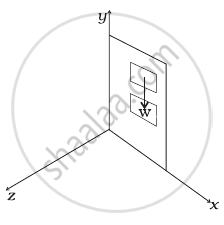Advertisements
Advertisements
प्रश्न
Two discs of moments of inertia I1 and I2 about their respective axes (normal to the disc and passing through the centre), and rotating with angular speed ω2 and ω2 are brought into contact face to face with their axes of rotation coincident.
- Does the law of conservation of angular momentum apply to the situation? why?
- Find the angular speed of the two-disc system.
- Calculate the loss in kinetic energy of the system in the process.
- Account for this loss.
उत्तर
a. As there is no net external torque on the system, the law of conservation of angular momentum may be applied.
Gravitational forces and their normal reactions are external forces, but their net torque is zero, therefore they have no impact.
b. By applying the Law of conversation of angular momentum,
`L_j = L_i`
⇒ `I_ω = I_1ω_1 + I_2ω_2`
I = moment of inertia
ω = angular speed
∴ ω = `(I_1ω_1 + ω_2ω_2)/I` ∴ I = I1 + I2
∴ ω = `(I_1ω_1 + ω_2ω_2)/I`
c. As `KE_f = KE_R + KE_T`
Translational Energy = 0
∴ KET = 0
∴ `KE_f = KE_R = 1/2 Iω^2 = 1/2 (I_1 + I_2) [(I_1ω_1 + I_2ω_2)/(I_1 + I_2)]^2`
`KE_f = 1/2 (I_1ω_1 + I_2ω_2)^2/((I_1 + I_2))`
`KE_i = KE_(1R) + KE_(2R) + KE_(1T) + KE_(2T)`
Because there is no translational motion which in turn results,
KE1T = 0
KE2T = 0
∴ `KE_i = 1/2 I_1ω_1^2 + 1/2 I_2ω_2^2 = 1/2 (I_1ω_1^2 + I_2ω_2^2)`
∴ `ΔKE = KE_f - KE_i = 1/2 (I_1ω_1 + I_2ω_2)^2/((I_1 + I_2)) - 1/2 (I_1ω_1^2 + I_2ω_2^2)`
= `1/2 [(I_1^2ω_1^2 + I_2^2ω_2^2 + 2I_1I_2ω_1ω_2 - [(I_1 + I_2)(I_1ω_1^2 + I_2w_2^2)]]/(I_1 + I_2)]`
= `[([I_1^2ω_1^2 + I_2^2ω_2^2 + 2I_1I_2ω_1ω_2] - [I_1^2ω_1^2 + I_2^2ω_2^2 + I_1I_2ω_1^2 + I_2^2ω_2^2])/(2(I_1 + I_2))]`
= `(-I_1I_2)/(2(I_1 + I_2)) (-2ω_1ω_2 + ω_2^2 + ω_1^2)`
ΔKE = `(-I_1I_2)/(2(I_1 + I_2)) (ω_1 - ω_2)^2 < 0`
d. `K_f < K_i` since energy is wasted due to friction between discs' moving surfaces.
APPEARS IN
संबंधित प्रश्न
Two particles, each of mass m and speed v, travel in opposite directions along parallel lines separated by a distance d. Show that the angular momentum vector of the two particle system is the same whatever be the point about which the angular momentum is taken.
A heavy particle of mass m falls freely near the earth's surface. What is the torque acting on this particle about a point 50 cm east to the line of motion? Does this torque produce any angular acceleration in the particle?
A particle of mass m is projected with a speed u at an angle θ with the horizontal. Find the torque of the weight of the particle about the point of projection when the particle is at the highest point.
Calculate the total torque acting on the body shown in the following figure about the point O.

A particle is moving with a constant velocity along a line parallel to the positive X-axis. The magnitude of its angular momentum with respect to the origin is, ______
A rope is wound around a hollow cylinder of mass 3 kg and radius 40 cm. What is the angular acceleration of the cylinder if the rope is pulled with a force of 30 N?
A Merry-go-round, made of a ring-like platform of radius R and mass M, is revolving with angular speed ω. A person of mass M is standing on it. At one instant, the person jumps off the round, radially away from the centre of the round (as seen from the round). The speed of the round afterwards is ______.
The net external torque on a system of particles about an axis is zero. Which of the following are compatible with it?
- The forces may be acting radially from a point on the axis.
- The forces may be acting on the axis of rotation.
- The forces may be acting parallel to the axis of rotation.
- The torque caused by some forces may be equal and opposite to that caused by other forces.
A door is hinged at one end and is free to rotate about a vertical axis (Figure). Does its weight cause any torque about this axis? Give reason for your answer.

Angular momentum of a single particle moving with constant speed along the circular path ______.
